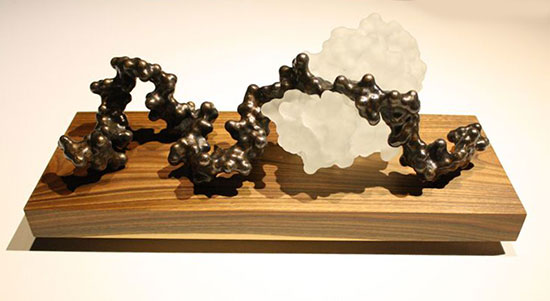Inside King Street Station in Seattle, the gallery was humming with noises of all kinds. It was the first night of 9e2 Seattle, a festival exploring the “intersection of art, science, and technology” over nine evenings of performance, installations and discussions.
Above the din of gallery goers chatting over drinks, there were the clicks and whistles of Flock The Optic, a sensor-operated installation about the migrations of snow geese, and the soundscapes of The Oregon Project, a project aimed at allowing visually impaired people to “hear” a painting. In the far corner, participants were donning VR headsets to explore an abstract landscape with geometric forms that generated their own sounds.
“This isn’t art that you can just hang on a wall,” festival organizer John Boylan explained during his introduction. Proving his point, the festival opened with a “performance” by, well, a box. Artist Mary Sherman designed Eri, After Dark (named after a Haruki Murakami novel) as a sort of self-opening gift, a box that opens itself slowly as opera music and the shadows of the moving lids create a haunting, temporal effect.
At first, the audience didn’t quite know how to react. Should we stand back? Go over to it? Touch it? Is there something inside it? Eventually, people moved into a circle around the box, gazing at it for a few more moments before it closed itself and ended the performance.
9e2 Seattle is a commemoration of the original “9 Evenings” held 50 years ago in New York City, after artists including John Cage, Deborah Hay, and Robert Rauschenberg spent 10 months collaborating with 30 engineers and scientists from Bell Telephone Laboratories to create unique live performances and artworks using the latest technology of the time: infrared cameras, video recording, and electronic music and sound.
.

"The Skies Epitomized" by Maja Petric. Photo by Amber Cortes.
.
According to the 9e2Seattle website, the expectation is that the festival will “leave a forward-looking legacy: new work, new bonds between artists and technologists, new ways of looking at and using technology, and a new awareness of the interconnections between science, technology, and art.”
Seattle, Boylan believes, is the perfect place to re-create this kind of festival with modern tech, “given that we have such a booming technology scene—not just the high tech, but all kinds of startups and small factories that are around, up to the latest from Google and Microsoft.”
The festival has managed to pull in sponsors from major tech companies in Seattle like Facebook, Google, and Microsoft, as well as support from arts organizations around the city.
9e2 artists consulted and collaborated with Microsoft researchers, University of Washington astrophysicists, neuroscientists, and statisticians to create audiovisual installations, computer-generated visual art, 3D gaming, interactive VR and augmented reality experiences, and more.
.

"Tears" by Mike Tyca. Photo by Amber Cortes.
.
There’s almost no scientific topic or theme left untouched in these pieces. Genetics, data visualization, biology, biochemistry, dark matter, ecology, and brain chemistry are all addressed in different ways. The performances feature a concert of code-inspired compositions by DJ Spooky; a musical ensemble that plays jazz created directly from the brain in real time; and a dance piece that utilizes surveillance technology.
Boylan noted that like New York City in 1966, Seattle and the 9e2 festival are perfectly positioned to play a vital role in the development and presentation of tech-based art as it continues its rapid pace of development.
“The question is: are we in a moment where the technologies that exist now will explode or not?” Boylan asked. “Are we going to look back at this time and all of the technologies we’re starting to experience now, from artificial intelligence, to driverless cars, and especially virtual reality and immersion, and see them blow up the same way it happened in the ’60s? And if that happens, what role will Seattle play in that?”
.

"The Observer Effect," a virtual reality collaboration from Reilly Donovan, Cory Metcalf, and David Stout. Photo by Amber Cortes.
.
___________________________
BASIC FACTS: The 9e2 Seattle art exhibition and performance series runs from October 21 through October 29, 2016 at King Street Station, 303 S. Jackson Street, Seattle WA 98104 and four satellite venues. www.9e2Seattle.org
_____________________________
Copyright 2016 Hamptons Art Hub LLC. All rights reserved.
